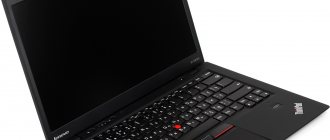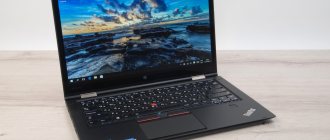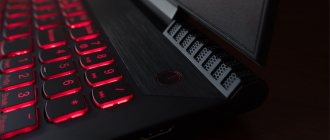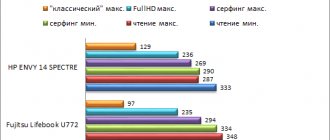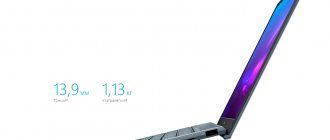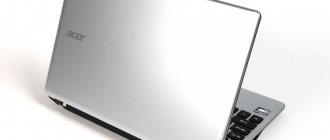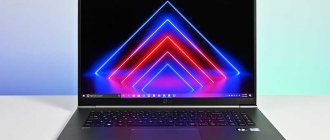The Lenovo ThinkPad X1 Extreme series of laptops, in addition to having a very impressive pedigree, has several advantages for those who need a powerful yet easily transportable laptop. The computer we tested is equipped with a fast 6-core Intel processor and GeForce GTX 1050 Ti discrete graphics. At the same time, “Extreme” can quite realistically be considered a compact model equipped with a 15-inch screen.
Lenovo ThinkPad X1 Extreme
⇡#Technical characteristics, equipment and software
You can find several modifications of the Lenovo ThinkPad X1 Extreme on sale, but each of them in any case uses GeForce GTX 1050 Ti mobile graphics in the Max-Q design. All possible iron combinations are listed in the table below.
| Lenovo ThinkPad X1 Extreme | |
| Display | 15.6", 1920 × 1080, IPS, matte 15.6", 3840 × 2160, IPS, glossy, touch |
| CPU | Intel Core i7-8750H, 6/12 cores/threads, 2.2 (4.1) GHz, 45 W Intel Core i5-8300H, 4/8 cores/threads, 2.3 (4.0) GHz, 45 W |
| Video card | NVIDIA GeForce GTX 1050 Ti Max-Q, 4 GB |
| RAM | Up to 64 GB, DDR4-2666, 2 channels |
| Installing drives | 2 × M.2 in PCI Express x4 3.0 or SATA 6 Gb/s mode |
| Optical drive | No |
| Interfaces | 2 × USB 3.1 Gen1 Type-A 2 × Thunderbolt 3 1 × USB 3.1 Gen2 Type-A 1 × 3.5 mm mini-jack 1 × HDMI 1 × smart card reader 1 × card reader 1 × mini-Ethernet |
| Built-in battery | 80 Wh |
| External power supply | 135 W |
| Dimensions | 361 × 245 × 18.4 mm |
| Laptop weight | With FHD - 1.7 kg With 4K - 1.8 kg |
| operating system | Windows 10 x64 Pro |
| Guarantee | 3 years |
| Price in Russia according to Yandex.Market | 201,000 rubles for a test model |
As you can see, perhaps the most advanced version of the Lenovo ThinkPad X1 Extreme arrived at our testing laboratory. Thus, the laptop is equipped with a 4K screen, a 6-core Core i7-8750H processor, 16 GB of RAM and a 512 GB solid-state drive. Such a modification costs an average of 201,000 rubles in Moscow retail. For a model with a Full HD display, Core i5-8300H, 16 GB of RAM and 256 GB SSD in the capital they are asking about 153,000 rubles. In all cases, a professional version of the Windows 10 operating system is installed on the laptop.
All Lenovo ThinkPad X1 Extreme series laptops are equipped with the Intel Wireless-AC 9560 wireless module, which supports IEEE 802.11b/g/n/ac standards with a frequency of 2.4 and 5 GHz and a maximum throughput of up to 1.73 Gbps and Bluetooth 5 .
The Extreme included only an external power supply with a power of 135 W and a weight of about 400 g.
THINK: a brief history of the ThinkPad, from IBM to Lenovo
At the beginning of the century, IBM was certainly at the top of the business laptop makers. But even despite the successful 90s for the company, the beginning of the 2000s was marked by some stagnation for it. IBM had already developed the ThinkPad naming scheme, but the lack of innovation and fresh design put the company in a difficult position.
The first models of the new decade were still successful: the T-series ThinkPad debuted with the ThinkPad T20 in May 2000. The laptop was a compromise between compactness and power, running on a Pentium III CPU. In the next ThinkPad X20 model of the same year, IBM again reduced the size, sacrificing processor clock speed and some other functions. Users who required more performance had an alternative in the ThinkPad A20p with a 15-inch TFT display (1400x1050), running on a 750 MHz Pentium III and an ATI Rage Mobility 128 graphics accelerator with 16 MB of video memory.
Both models will soon receive updated versions. The T series, as a business-oriented line, was intended for a wide range of tasks. The X series was designed for those who constantly travel and need a compact device, while the A series, on the contrary, claimed to be a desktop computer. The following year, the first budget R series laptop was introduced, the ThinkPad R30, which can be considered the ancestor of the current L series. There were also several stand-alone devices, such as the ThinkPad S30, which was sold only in Asian markets.
From year to year, various improvements were introduced into each series, without any experimentation. ThinkPad began to stagnate, so IBM tried to bring new ideas to the market, many of which ultimately did not take root. Perhaps the most notorious failure was the ThinkPad TransNote, a convertible notebook notebook. TransNote consisted of a fully functional tablet computer on one side and a paper notepad on the other. The device proved to be too niche a product and ultimately failed in the marketplace.
Unfortunately, IBM was unable to repeat its success and ended up losing a billion dollars in computer sales in 2004. That's why management decided to sell its entire line of PCs and laptops to Lenovo. The deal took place in May 2005, and the new owner of the ThinkPad brand hit the ground running.
The new ThinkPad T60 appeared on the market in January 2006 and breathed a second life into the line. The transition to Lenovo has had little impact on the device, with the T60 retaining many of the proven ThinkPad design cues. However, the laptop also introduced something that would revolutionize the computing world: multi-core processors.
The T60 was the first ThinkPad to feature dual-core Intel Core Duo and Core 2 Duo processors. Also, the device was the first to use a magnesium alloy frame, which improved build quality, a 3G modem and much more. The T60 remains highly regarded among computer geeks as it is considered by many to be the last true ThinkPad, both due to its design and build quality, as well as its 4:3 aspect ratio screen. In particular, this laptop's fan base includes enthusiasts from the Linux community.
Under Lenovo's leadership, the ThinkPad brand received a second wind and a chance to dominate the market again.
⇡#Appearance and input devices
Just one word - ThinkPad - is enough to understand what a Lenovo laptop looks like. The Extreme body is made entirely of plastic. All parts, except the display frame, are equipped with a velvety soft touch coating. The material is not easily soiled - after two weeks of working with the device, I can confidently say that fingerprints are mainly attracted only by the touchpad, while the rest of the parts remain clean.
When turned off, the Lenovo ThinkPad X1 Extreme appears to have an almost edge-to-edge display. However, it is not. In the case of the test model, the 4K display is placed in a black frame. As a result, the total thickness of the frames on the left and right is 8 mm, on the top - 13 mm, on the bottom - 23 mm. The webcam is located on top.
The laptop lid on the Lenovo ThinkPad X1 Extreme opens 180 degrees, which is generally typical for this series. Unfortunately, you won’t be able to open the laptop with one hand: the design of the laptop uses fairly tight hinges, which, however, allow you to hold the screen clearly and securely.
As I already said, the undoubted advantages of the ThinkPad X1 Extreme are its size and weight. Thus, any version of a Lenovo laptop weighs less than 2 kg, so carrying the device with you every day will not be difficult. The thickness of “Extreme” is only 18.4 mm.
On the left side of the Lenovo ThinkPad X1 Extreme there is a connector for connecting a power supply, two Thunderbolt 3 ports combined with USB 3.1 Gen2 C-type, an HDMI 2.0 output, a mini-Ethernet connector (an adapter to a full RJ-45 is included) and 3 .5 mm headphone jack. On the right side of the laptop there is a smart card reader, a card reader that supports 4 formats of external storage devices, two USB 3.1 Gen1 A-type and a Kensington lock slot.
In my opinion, the functionality of the model in question is all right. As you can see, the Lenovo ThinkPad X1 Extreme supports up to four independent monitors. Additionally, the optional IR camera supports Glance technology for comprehensive facial, iris and eye movement detection. For example, it can be used to move windows just by moving your eyes.
The Lenovo ThinkPad X1 Extreme keyboard is a true classic. Of course, for those users who have never encountered such a keyboard, it will be unusual at first to deal with the left Ctrl, non-standard PgUp, PgDn and PrtSc, but you quickly get used to this arrangement of buttons. But “Extreme” has very large and convenient Shift, Enter, Tab and Backspace. And, unlike many ultrabooks, the ThinkPad X1 Extreme has quite a lot of key travel, with a noticeable, crisp click. Typing on this keyboard is very comfortable. The F1-F12 row works in combination with the Fn button by default, while priority is given to their multimedia functions.
The keyboard in the Lenovo ThinkPad X1 Extreme is equipped with a two-level white backlight. On the right side of the case there is a Match-on-Chip fingerprint sensor. Like all other full-fledged ThinkPads, the X1 Extreme is equipped with two pointing devices: a touchpad with three buttons and a TrackPoint mini-joystick. The manufacturer claims that the Lenovo ThinkPad X1 Extreme is not afraid of even liquid getting on the keyboard.
The touch panel of the device is quite convenient to use. The coating at first glance seems the same as on the body, but in reality it turns out to be more “rubbery” and more pleasant to the touch.
As for the webcam, the Lenovo ThinkPad X1 Extreme uses a matrix with a resolution of 720p and a frequency of 30 Hz. This is enough for Skype calls - and that's it. I will add that unlocking the operating system is also possible using face identification (Windows Hello technology), and controlling various functions using a voice command system (virtual assistant Cortana).
The webcam is equipped with a ThinkShutter security shutter - useful for those who believe that Big Brother is watching them.
Lenovo ThinkPad 10 – Design and Specifications
Lenovo ThinkPad 10 is evidence that tablets running Intel processors and the Windows operating system are already close in performance to iPad and Android tablets.
With dimensions of 256.5 x 177 x 8.95 mm, it is slightly larger than the iPad Air 2 (240 x 169.5 x 6.1 mm). It also weighs a little more at 597 grams, compared to 437 grams for Apple tablets. So the tablet should fit comfortably in one hand, but, unfortunately, this is not the case.
Lenovo decided to make the two bottom corners, which are located on either side of the Windows button, pointed instead of rounded. Because of this, the tablet fits uncomfortably into the palm of your hand when held with one hand.
The company decided that with a flat edge, the tablet would work better with an additional keyboard. However, it doesn't come standard, so we'll judge the tablet as a standalone unit.
Other than that, the design of the tablet is quite attractive: black, tactile plastic covers the back and the neat ThinkPad logo, complete with backlighting above the “i,” looks very interesting. However, the Intel logo and other information located on the back slightly spoil the appearance. You won't even be able to remove it, as you can with similar stickers on Windows laptops.
Also on the back panel there are two stereo speakers, as well as a 5 MP camera with LED flash and a fingerprint scanner. On the reverse side there is a 1.2 megapixel front camera, just opposite the Windows touch button, which can also be used to unlock the tablet.
Another physical button that can unlock the device is located at the top. It also turns off the device when you press it for a long time. On the bottom surface you can find a hole for connecting to the docking station, the remaining buttons and functional holes are located on the right side of the tablet.
Here you can find a USB Type-C port, USB 3.0 port, Micro HDMI, SIM slot, MicroSD, volume controls and a headphone jack. This decent feature set for a tablet makes it a versatile device.
The characteristics of the display with a resolution of 1920 by 1200 pixels are complemented by a dual-core Intel Atom x7-Z8700 processor with a frequency of 1.6 GHz with Intel HD Graphics, 2 or 4 GB of RAM, depending on the selected configuration. In addition, the buyer can choose a modification with 64 or 128 GB of built-in flash memory. All models support Wi-Fi 802.11ac and Bluetooth 4.0. The cost of the tablet starts from $670 in the initial configuration and goes up to $1050.
⇡#Internal structure and upgrade options
The laptop is quite easy to disassemble: unscrew a few screws and carefully remove the plastic bottom.
As you can see, the processor and mobile graphics are cooled by a single array of heat pipes and fans. Since the system uses a fairly powerful 45-watt CPU, there are some concerns about how efficient such a cooler will be. At the same time, the manufacturer claims that the device meets the requirements of twelve military standards, and has also passed more than 200 tests for performance under extreme conditions. It is claimed that the Lenovo ThinkPad X1 Extreme will work reliably in arctic snow and dust storms, in zero gravity and in pouring rain.
The test unit has 16 GB of RAM in the form of a single Samsung module. The die operates at an effective frequency of 2666 MHz with a latency of 19-19-19-43. The Windows operating system is installed on a 512 GB Intel SSDPEKKF512G8L NVMe drive. There is no option to install a 2.5-inch hard drive or SSD in the Lenovo ThinkPad X1 Extreme.
Possible actions for the subsequent upgrade of the laptop are obvious: another 16 GB RAM module is just asking for it. You will also be able to install a second SSD over time, since the Lenovo ThinkPad X1 Extreme motherboard is equipped with two M.2 slots.
⇡# Specifications
| Lenovo ThinkPad T430u | |
| Screen | 14.0 inches, 1366×768; TN technology, LED backlight (AU Optronics B140XTN02.5); Matte finish |
| CPU | Intel Core i3-3217U: 1.8 GHz; 2x256 KB L2; 3 MB L3; two computing cores; TDP 17 W |
| Graphic arts | NVIDIA GeForce GT 620M, 1 GB DDR3 Intel HD 4000, integrated into the processor Automatic graphics switching NVIDIA Optimus |
| Chipset | Intel UM77 |
| RAM | 4 GB, DDR3-1600 (two expansion slots) |
| HDD | HDD 500 GB, 7200 rpm (Hitachi HTS725050A7E630) Form factor 2.5 inches, 7 mm Free slot for SSD in mSATA form factor |
| Optical drive | — |
| Flash card connector | SD/MMC |
| Interfaces | 2 x USB 3.0 1 x HDMI 1 x Mini DisplayPort 1 x RJ-45 1 x combined audio jack (mini-jack 3.5 mm) |
| 3G | In some configurations |
| WiFi | 802.11b/g/n, 2x2, 2.4 GHz (Intel Centrino Wireless-N 2230BGN) |
| Bluetooth | 4.0 |
| Network adapter | 10/100/1000 Mbps (Realtek RTL8168/8111) |
| Sound | Realtek ALC269 Two speakers, two microphones |
| Battery | Non-removable, made of three flat elements Nominal capacity 47 Wh (4250 mAh; 11.1 V) Minimum capacity 41.3 Wh (3720 mAh; 11.1 V) |
| Declared sizes | 340x236x21 mm |
| Declared weight | 1.852 kg |
| operating system | Windows 7 Professional SP1 (64 bit) |
| Guarantee | 3 years |
| approximate price | From 30,000 rub. |
⇡#Testing methodology
Since the laptop does not have the most powerful graphics solution installed, there is no point in using exclusively the maximum or close to maximum graphics quality settings. In addition, when testing the Lenovo ThinkPad X1 Extreme, only Full HD resolution was used, although the laptop is equipped with a 4K display.
| API | Quality | Full screen anti-aliasing | |
| 1920 × 1080 | |||
| The Witcher 3: Wild Hunt, Novigrad and surroundings | DirectX 11 | Max. quality | A.A. |
| High | |||
| GTA V, built-in benchmark | Max. quality | 4 × MSAA + FXAA | |
| No smoothing | |||
| FarCry 5, built-in benchmark | Max. quality, HD textures off. | TAA | |
| High | TAA | ||
| Assassin's Creed Odyssey, built-in benchmark | The highest | High | |
| High | No smoothing | ||
| Dota 2, match recording | Max. quality | No smoothing | |
| World of Tanks 1.0, EnCore benchmark | Max. quality | TSSAA HQ | |
| Total War: WARHAMMER II, built-in benchmark | DirectX 12 | Max. quality | 4xMSAA |
| High | No smoothing | ||
| Battlefield V, mission "The Last Tiger" | Ultra | TAA | |
| High | |||
| Shadow of the Tomb Raider, built-in benchmark | Max. quality | SMAAT2x | |
| High | No smoothing | ||
| Metro Exodus, Volga | Extreme, NVIDIA HairWorks on, Physics on. | ||
| High, NVIDIA HairWorks on, Physics on |
Gaming performance was determined using the well-known FRAPS program. With its help, we get the rendering time of each frame. Then, using the FRAFS Bench Viewer utility, not only the average FPS is calculated, but also the 99th percentile. The use of the 99th percentile instead of the minimum number of frames per second indicators is due to the desire to clear the results from random bursts of performance that were provoked by reasons not directly related to the operation of the main components of the platform.
Processor and memory performance were measured using the following software:
- Corona 1.3. Testing rendering speed using the renderer of the same name. The speed of building a standard BTR scene used to measure performance is measured.
- WinRAR 5.40. Archiving an 11 GB folder with various data in RAR5 format and with the maximum degree of compression.
- Blender 2.79. Determining the final rendering speed in one of the popular free 3D graphics packages. The duration of building the final model from Blender Cycles Benchmark rev4 is measured.
- x264 FHD Benchmark. Testing the speed of video transcoding to H.264/AVC format.
- x265 HD Benchmark. Testing the speed of video transcoding to H.265/HEVC format.
- CINEBENCH R15. Measuring the performance of photorealistic 3D rendering in the CINEMA 4D animation package, CPU test.
- Fritz 9 Chess Benchmarks. Testing the speed of a popular chess engine.
Display testing is done using the X-Rite i1Display Pro colorimeter and the HCFR app.
The battery life of a laptop is checked in three modes. The first load option - web surfing - involves alternately opening and closing tabs on the sites 3DNews.ru, Computeruniverse.ru and Unsplash.com with an interval of 30 seconds. This test uses the Google Chrome browser with the "Block third-party data and cookies" and "Don't allow sites to store data" options enabled. In the second mode, x265 (HEVC) video is played in a standard Windows 10 player with the repeat function activated. The third type of load is running the Unigine Heaven benchmark at maximum graphics quality settings in full screen mode. In all three cases, the same display brightness was set at 220 cd/m2.
The results of the following laptops were reviewed in games and other applications:
| Test participants | ||||||
| Model | Screen | CPU | RAM | Graphic arts | Storage device | Battery |
| MSI GE73VR 7RF Raider | 17.3", 1920 × 1080, TN | Intel Core i7-7700HQ, 4/8 cores/threads, 2.8 (3.8) GHz, 45 W | 16 GB, DDR4-2400, two channels | NVIDIA GeForce GTX 1070, 8 GB GDDR5 | HDD, 1 TB, 7200 rpm + 2 × SSD, 256 GB, SATA 6 Gbit/s | 51 Wh |
| MSI GE73 Raider RGB 8RF | 17.3", 1920 × 1080, TN | Intel Core i7-8750H, 6/12 cores/threads, 2.2 (4.1) GHz, 45 W | 32 GB, DDR4-2400, two channels | NVIDIA GeForce GTX 1070, 8 GB GDDR5 | HDD, 1 TB, 7200 rpm + SSD, 256 GB, SATA 6 Gbit/s | 51 Wh |
| ASUS ROG Strix GL553VE | 15.6", 1920 × 1080, IPS | Intel Core i7-7700HQ, 4/8 cores/threads, 2.8 (3.8) GHz, 45 W | 16 GB, DDR4-2400, two channels | NVIDIA GeForce GTX 1050 Ti, 4 GB GDDR5 | HDD, 1 TB, 5400 rpm + SSD, 128 GB, SATA 6 Gb/s | 48 Wh |
| Lenovo ThinkPad X1 Extreme | 15.6", 3840 × 2160, IPS | Intel Core i7-8750H, 6/12 cores/threads, 2.2 (4.1) GHz, 45 W | 16 GB, DDR4-2666, single channel | NVIDIA GeForce GTX 1050 T Max-Qi, 4 GB GDDR5 | SSD, 512 GB, PCI Express x4 3.0 | 80 Wh |
⇡#Display and sound
As noted in the first part of the review, you will find versions of the Lenovo ThinkPad X1 Extreme with Full HD and 4K screens on sale. In the second case, the display is equipped with a glossy touch coating - with all the attendant pros and cons. The test sample uses an AU Optronics B156ZAN03.2 IPS matrix. The display is notable for the fact that it claims to support playback of HDR content.
The Lenovo ThinkPad X1 Extreme is great for watching movies. Thus, the matrix contrast is 1467:1. The minimum luminosity of white is 3 cd/m2, and the maximum is 389 cd/m2. It turns out that the laptop is comfortable to use both in pitch darkness and in clear sunny weather. Gamma is 2.29, slightly higher than the reference value of 2.2.
Gamma | Color gamut | Colorful temperature |
Measurements with a colorimeter showed that the color temperature of the display throughout the entire range is noticeably higher than the reference value of 6500 K, but at the same time good stability of gray shades is observed. Largely because of this, the average DeltaE error on the gray scale is quite high - 7.9 with a maximum value of 12. But the average in the ColorChecker24 test was 4.58 with a maximum deviation of 8.35. The color gamut of the AU Optronics B156ZAN03.2 noticeably exceeds the sRGB standard, but due to deviations in color rendition, it does not fully correspond to the AdobeRGB standard.
The test model has a pronounced highlight in the upper left corner of the screen. However, it is not at all a fact that this applies to all copies. Therefore, before purchasing, it is better to personally check the laptop for such shortcomings - I can safely say that they are strictly local in nature. The Glow effect, like most IPS matrices, is present, but it appears mainly on a black field. The AUO screen has excellent viewing angles both vertically and horizontally. Finally, the matrix used is a Flicker-Free solution over the entire operating brightness range.
The sound from the speakers of the Lenovo ThinkPad X1 Extreme is flat - there are no low frequencies, and in a laptop with a thickness of 18 mm they have nowhere to appear. The mids and highs also sound inexpressive, especially the upper ones. And the speakers of the Lenovo ThinkPad X1 Extreme cannot be called loud.
ThinkPad X
The lightweight and durable chassis of the premium X-series laptops allows you to take them with you anywhere. Super power, excellent build quality, in general - a complete set of everything you need for work and play.
What the models will delight you with:
- lightness - almost all devices weigh a little more than a kilogram;
- fearless and durable thanks to the reinforced body: models are not afraid of dust, moisture and shock;
- battery life: Lenovo gave the ThinkPad X the ability to last up to 15 hours without recharging.
Here are the most remarkable laptops in this series: even when comparing which is better, it’s difficult to decide.
ThinkPad X1 Carbon
The diagonal of the display is only 14 inches, but at the same time it is not inferior to anyone in terms of saturation. The fact is that in most configurations the device is equipped with excellent HDR monitors that can cover 100% RGB.
What else is good about this laptop in any configuration:
- Productivity is what you need. Quad-core eight-thread processors from Intel (Core i5 or i7) with a decent supply of RAM (8-16 GB) allow laptops to quickly respond to user requests and run several resource-intensive programs at the same time.
- Information is reliably protected from strangers: models recognize the owner by face, and are also equipped with a fingerprint sensor.
- The display is framed by very narrow frames, which makes it visually appear larger.
- Such a device is not short on durability: but of course, it is reinforced with carbon fiber and also has a keyboard that is protected from moisture. The laptop can easily survive a fall, shock, moisture and temperature changes: you can work in almost any conditions.
- Thanks to the built-in Thunderbolt 3, the device charges quickly: in an hour the charge is replenished by 80%.
ThinkPad X1 YOGA
The super-light 2-in-1 model has the same display diagonal as the previous version and the same color gamut. The device is equipped with an eighth generation Intel processor, which provides excellent performance and makes it an excellent solution for resource-intensive work.
The main features of X1 YOGA:
- Performance is provided by the Core i7-8650U with a frequency of 2.11 GHz coupled with 16 gigabytes of RAM.
- For a 14" diagonal, the resolution is simply amazing - 2560x1440 pixels, which gives a high-definition image. Excellent viewing angles (178 degrees) and realistic colors are achieved thanks to the IPS matrix.
- The proprietary Vantage option provides flexible display settings. The user can adjust the color temperature from 3.5 to 6.5 thousand Kelvin. In addition, Vantage offers seven screen presets: 6 presets to choose from and a seventh that is customizable.
- The abundance of ports is also pleasing. In addition to the standard HDMI, mini-DisplayPort, Ethernet connector and combined audio input, the laptop is equipped with 4 USB ports: two of them are USB 3.1 Type C (Thunderbolt 3), and two more are USB 3.0/3.1.
- The hinge connecting the screen and keyboard parts rotates at an angle of 360 degrees, which allows you to use the model both as a laptop and as a tablet.
- It’s convenient to draw and take notes: Lenovo included a stylus in the kit.
- Equipped with a Wave keyboard, which itself hides the keys when switching to tablet mode.
More details about the model: Lenovo ThinkPad X1 Yoga review
⇡#Laptop performance in resource-intensive applications
For a long time, the factor that determines the performance of any laptop is the efficiency of its cooling system. This dependence became especially critical with the advent of 6-core Coffee Lake processors. Starting this year, I decided to study in more detail the capabilities of the laptop cooling system, as well as to identify the dependence of the level of performance of the CPU, GPU and RAM on the quality of the cooler used in the system. In particular, from now on testing takes place not only in the default mode, but also after manual configuration in the Intel Extreme Tuning Utility program. But Intel will soon introduce 8-core laptop chips...
Programs like LinX and Prime95 are a litmus test for modern laptops built on Coffee Lake chips. As you know, the clock frequency of the Core i7-8750H is 2.2 GHz, but in Turbo Boost mode, when all six cores are loaded, it can increase to 3.9 GHz. Only the TDP level of this chip is 45 W, and in some cases this power limit is not enough for the mobile CPU to work to its fullest.
Confirmation of my words is in the screenshot above. The Core i7-8750H used in the Lenovo ThinkPad X1 Extreme drops the frequency in the LinX program from 3.9 to 2.0 GHz - we are seeing throttling at 200 MHz. This sharp drop in frequency is primarily due to the 45-watt TDP limitation. However, in the case of the Lenovo ThinkPad X1 Extreme, the 6-core Intel would still not be able to operate at a frequency of 3.9 GHz (for example, if we had the opportunity to increase the level of typical CPU power consumption), since the temperature of its hottest core reaches 98 degrees Celcius. But, by the way, in this mode the laptop behaves quite quietly - from a distance of 30 centimeters, the sound level meter recorded 39.7 dBA.
Well, in the Intel Extreme Tuning Utility program in Offset mode, I was able to reduce the CPU supply voltage by 0.185 V. As you can see, the Core i7-8750H has a rather high VCore parameter in default mode. This downvolting significantly reduced the appetite of the 6-core processor - in the same LinX its frequency was now reduced to 2.5 GHz with the same Core Max parameters and noise level. It turns out that we accelerated the Lenovo ThinkPad X1 Extreme by 500 MHz with the press of just one button.
In other programs, in default mode, the Core i7-8750H ran at 3.3 GHz - Turbo Boost was turned on, but not at full strength. In this case, the cooling system is to blame, which, as we have already found out, consists of only two heat pipes. Lowering the processor voltage allowed the chip to operate at full capacity, which led to a noticeable increase in performance in almost all programs. For example, in x265 Benchmark the laptop became 11% faster, and in CINEBENCH R15 - by 12%.
It so happens that the 6-core Core i7-8750H processor is used mainly in gaming laptops, which, as a rule, cannot boast of light weight and compactness. In particular, we compared the Lenovo ThinkPad X1 Extreme with the 17-inch MSI model. As you can see, drops in the clock frequency of the central processor lead to the fact that “Extreme” in some tests seriously lags behind a laptop with a more efficient cooling system. However, independently reducing the CPU voltage paid off - the Lenovo ThinkPad X1 Extreme began to work noticeably faster.
Do not forget that the RAM of the laptop in question operates in single-channel mode. The manufacturer’s logic is clear: a free SO-DIMM slot on the motherboard is left for a subsequent “painless” system upgrade.
⇡#Laptop performance in games
Lenovo ThinkPad X1 Extreme is notable for the fact that it uses GeForce GTX 1050 Ti mobile graphics in Max-Q design. This means that the laptop has a more energy-efficient GPU that operates at lower frequencies. See for yourself: the frequency of the graphics core of the “regular” GeForce GTX 1050 Ti in ASUS ROG Strix GL553VE in games varies in the range from 1696 to 1734 MHz; in a Lenovo device, the GPU operates within the range of 1342-1658 MHz. Naturally, such a reduction in frequency will affect the laptop's performance in games.
Let me draw your attention to the fact that in games the GPU heats up to 75 degrees Celsius. The temperature of the hottest CPU core rises to 97 degrees Celsius, and the Core i7-8750H frequency drops from 3.9 to 2.4 GHz. At the same time, the Lenovo ThinkPad X1 Extreme operates quite quietly - from a distance of 30 cm, the sound level meter recorded a value of 39.2 dBA.
Reducing the CPU voltage by 0.185 V, by the way, also brought benefits in games. In the same Dota, the frequency of the Core i7-8750H was now reduced only to 3.3 GHz, and the maximum temperature of the chip was already 91 degrees Celsius.
Of course, the Lenovo ThinkPad X1 Extreme will be inferior in games to laptops with a full-fledged mobile version of the GeForce GTX 1050 Ti. For example, in the 3DMark Time Spy test the difference in scores reaches 4% in favor of the ASUS ROG Strix GL553VE.
The table below clearly shows that the performance level of the Lenovo ThinkPad X1 Extreme and its GeForce GTX 1050 Ti Max-Q is now sufficient to comfortably play modern games in Full HD resolution using mostly medium and high graphics quality settings. However, this model can easily be given some concessions, because it is not positioned by the manufacturer as a purely gaming machine. It would be more correct to say this: the Lenovo ThinkPad X1 Extreme is suitable not only for work, but also for games.
| Lenovo ThinkPad X1 Extreme | |||
| Graphics quality | AVG FPS | MIN FPS | |
| The Witcher 3: Wild Hunt, Novigrad and surroundings | Max. quality | 33 | 16 |
| High | 41 | 29 | |
| GTA V, built-in benchmark | Max. quality | 32 | 20 |
| High | 41 | 28 | |
| FarCry 5, built-in benchmark | Max. quality, AA incl. | 31 | 17 |
| Max. quality, AA off | 33 | 19 | |
| Assassin's Creed Odyssey, built-in benchmark | Max. quality | 19 | 13 |
| High | 38 | 27 | |
| Dota 2, match recording | Ultra | 86 | 54 |
| World of Tanks 1.0, EnCore benchmark | High | 58 | 43 |
| Total War: WARHAMMER II, built-in benchmark | Max. quality | 21 | 17 |
| High | 44 | 31 | |
| Battlefield V, mission "The Last Tiger" | Max. quality | 34 | 24 |
| High | 38 | 26 | |
| Shadow of the Tomb Raider, built-in benchmark | Max. quality | 27 | 19 |
| High | 33 | 27 | |
| Metro Exodus, Volga | Extreme | 22 | 14 |
| High | 34 | 19 | |
Screen, sound
Our test sample has an IPS matrix and, accordingly, wide viewing angles and excellent color rendition. The 1366x768 resolution is perfect for a 12.5-inch diagonal. More would be too much, but less would be somehow not respectable for a laptop of this level and cost. Please note that the presence of an IPS matrix is optional - the cheapest modifications of the X230 can have a regular TN matrix.
The previous model, Lenovo ThinkPad X220, had a fairly quiet audio system. It is clear that this laptop is intended for serious people and serious work, and not for organizing discos. And the dimensions of the case itself will not allow you to fit good speakers and a subwoofer inside. But Lenovo still wisely decided that there should be as few weak points as possible, and equipped the Lenovo ThinkPad X230 with a much louder stereo system. The sound, of course, still remains rather symbolic due to the lack of low frequencies, which, in truth, is inherent in all small laptops.
⇡#Disk subsystem performance
You are unlikely to want to change the main storage device in the Lenovo ThinkPad X1 Extreme - 512 GB is enough to install all the main programs, as well as, for example, several games. According to the technical specifications, the linear read speed of the Intel SSDPEKNW512G8 reaches 1500 MB/s, and the sequential write speed reaches 1000 MB/s. This drive belongs to the 660p series, a detailed review of which was recently published on our website.
Lenovo ThinkPad X201 laptop review
At first glance, the set of ports presented in the laptop is very poor: 3 USB 2.0, no eSATA, no Firewire, no USB 3.0. There is not even a digital output for connecting an external monitor in the form of Displayport or HDMI. To do this you will have to use an analog VGA interface
.
With a resolution of 1280x1024 pixels, this port allows you to display a very good picture, but if you increase the resolution of the external monitor to 1680x1050, the picture turns out blurry. The data transfer speed through USB ports is around 27.4 MB/s, and the card reader's reading speed on average does not exceed 9.7 MB/s. The Gigabit LAN port in the laptop is mandatory for all modern devices, while the presence of a modem
(regular
RJ-11
) surprised us. Its presence is likely due to the fact that business users often use many older devices, such as fax machines.
Also very popular in the business world are laptops with the ability to use a docking station.
.
It makes it easier to use a laptop while stationary, and in addition, it often has the ability to use additional interfaces for which there was no room on the laptop. Thus, you can freely use various monitors, printers, input devices and other peripherals. Another possible option for connecting such devices is via ExpressCard/54
.
This connector allows you to use various port adapters, TV tuners, 3G modems and much more. However, our test sample had all, in our opinion, the necessary interfaces, so we did not need this functionality. A special feature of ExpressCard is a special mechanism
that protects the inserted card and prevents it from being accidentally removed.
Also, the laptop uses Trusted Platform Module 2.1, a fingerprint reader and hard drive protection during acceleration. Wireless communications capabilities
ThinkPad X201 can be called exemplary: Wi-Fi 802.11n, Bluetooth 2.1+EDR, WWAN (UMTS/HSDPA) - everything that can be useful to the user for mobile use. All wireless communication modules can be activated and deactivated through combinations with Fn, or using a hardware switch on the left side of the laptop.
The description of communication capabilities ends with a mention of a webcam, card reader and a number of interesting functions
, such as Thinklight - a flashlight for illuminating the keyboard, the Thinkvantage button (a program that allows automatic system setup, driver updates, and also offers system recovery capabilities), and constantly powered USB ports that can be used to charge MP3 players, phones and other small appliances even when the laptop is turned off.
⇡#Autonomous work
The laptop has four battery cells with a total capacity of 80 Wh. According to the manufacturer's internal tests, the laptop can last 15 hours. I noticed that our battery life tests put noticeably more stress on the system. In particular, this is due to the fact that I set the screen brightness to a fairly high level, at which it is comfortable to work during the day. Many laptops have already been tested using this method. If the device can last 6-8 hours in web surfing mode, then its battery life can safely be considered good. As you can see, the Lenovo ThinkPad X1 Extreme for a 15-inch laptop with a 4K display has good battery life - more than six hours both when playing video and surfing the web.
The laptop also supports fast battery charging, which allows you to recharge the battery by 80% in just one hour.
| Battery life, 220 cd/m2 | |
| Web (opening tabs in Google Chrome) | 6 h 6 min |
| Video viewing (4K, x265, HEVC) | 6 h 12 min |
| Games (UNIGINE Heaven, max settings) | 1 hour 7 minutes |
Lenovo ThinkPad 10 Tablet Preview
Ever since Apple's tablets, including the iPad Air, hit the scene as serious players, Microsoft and Google have rushed to snatch up what's left behind them. The latest rival to the mighty iPad, which seems the most worthy compared to the rest, is the Lenovo ThinkPad 10 tablet.
It's a rugged, 10.1-inch Windows 8.1 tablet that becomes the grown-up version of the Lenovo ThinkPad 8. During our preview in New York, we got to spend some time with the device—not to mention the countless accessories. Despite the short duration of the review, there was enough time to evaluate the aluminum body and Gorilla Glass panel.
With a slightly out-of-place, asymmetrical design, the Lenovo ThinkPad 10 is another laptop-tablet hybrid, although this time the design puts the emphasis on the tablet. At least the unusual design makes sense: the flat bottom of the tablet has multiple accessory docks, allowing for multiple use cases.
Cases and docks L enovo
ThinkPad 10
Lenovo is positioning the ThinkPad 10 as an all-in-one business solution as possible, hence the five accessories that accompany the device. Along with full support for up to 10 touches on the touchpad, Lenovo offers a digital pen for working with the tablet.
And if you want a Lenovo ThinkPad 10 case, how about two? The first case is a hard and functional Touchcase, similar in design to the Touch Cover from Microsoft. However, despite the typically disappointing touch keyboard design, the case has a clear demarcation between the keys and a soft, touch-sensitive surface for supposedly effortless typing. We haven't had a chance to test this.
Next up is the Quickshot Cover, which was found on the ThinkPad 8. The new cover is no different from the one used by our tablet's younger brother. The case uses the same ID, which serves the same purpose: it instantly activates the camera. You will love this feature when you are shooting. At least the tablet offers an 8-megapixel camera with auto focus and flash.
Finally, your ThinkPad 10 has a dock that's like all Lenovo docks (the charging station offers USB 3.0, HDMI and Ethernet ports) and an Ultrabook keyboard. As the name suggests, this is a dock with a mechanical keyboard and two slots for fixing a tablet, which is installed inside. We're not sure the tablet will be effective in a business setting beyond display, but time will tell.
Hot iron
While the versatility and range of accessories may make the ThinkPad 10 a different device, the hardware remains the same and requires careful consideration. Behind that 1920 x 1080 pixel IPS panel lies powerful hardware.
In addition to the quad-core Intel Atom Z3795 processor, the ThinkPad 10 comes in several configurations, equipped with up to 4 GB of DDR3 RAM and up to 128 GB of EMMC flash memory. On the front panel of the tablet you will find a 2-megapixel web camera with 720p video recording capabilities.
In terms of connectivity, Lenovo equips the tablet with Micro HDMI, USB 2.0 and a MicroSD card reader in addition to 802.11/B/G/N Wi-Fi. So while the tablet may not be as good as the iPad Air in display quality or wireless speed, it offers a better transformation. Additionally, Lenovo promises 10 hours of battery life, but this needs to be tested.
Early verdict
From a purely hardware perspective, the Lenovo ThinkPad 10 impresses with its quality hardware and premium materials. But we won't miss the opportunity to mention that the tablet's design feels quite awkward in the hands, especially in portrait mode.
Clearly, the device is shaped to fit the countless accessories that Lenovo plans to sell with the tablet. But couldn't the cases and docks be built to fit a better tablet design? After all, the Lenovo ThinkPad 10 tablet is difficult to hold.
Starting with a price tag of 21,000 rubles, the ThinkPad 10 is not the cheapest device, but due to its characteristics, the price is justified. Problems begin when you start needing accessories, the cost of which varies from 2,100 rubles. up to 4,500 rubles, they increase the cost of the tablet far beyond reasonable limits, but you have no choice when you need a full-fledged device. In addition, a large set of products always turns out to be a nightmare for the IT buyer, this already becomes a reason to think about it.
The Lenovo ThinkPad 10 is a carefully crafted tablet with a unique approach to the business market.
But don't you think that the abundance of accessories promises too much weight for the average worker's shoulder bag? We'll be preparing a full review soon. LenovoThinkPadThinkPad 10
⇡#Conclusions
The Lenovo ThinkPad X1 Extreme can be treated differently. Some of the advantages of the reviewed laptop are undeniable: this is a fairly light, compact and easy-to-handle “tag” that you can always take with you, for example to work. The device has a high-quality case, a comfortable and time-tested keyboard, modern interfaces, a capacious battery, and a high-quality 4K screen. A potential owner of the Lenovo ThinkPad X1 Extreme might be looking for a whole host of security features: FIDO authentication, dTPM 2.0, Match-on-Chip touch fingerprint scanner, Windows Hello with facial recognition, ThinkShutter, smart card reader and Kensington lock. It turns out that the Lenovo ThinkPad X1 Extreme perfectly combines the features of both corporate and multimedia laptops.
However, some advantages of the device also gave rise to its disadvantages. In particular, the 6-core Lenovo ThinkPad X1 Extreme processor gets very hot and does not always operate at the frequency set by Intel. The cooling system of the laptop can be called quiet. If you are satisfied with these rules of the game, then you can safely take a closer look at purchasing this device. If you are ready to part with 200,000 rubles, of course.
Interfaces, wireless communications
Owners of a Lenovo ThinkPad X220 are unlikely to feel much difference from purchasing a Lenovo ThinkPad X230, if we talk only about interfaces. Much remains in place, the changes are quite minor. Even the edges of the laptop look almost the same as before.
In the left corner there are ventilation holes for the cooling system, but they take up quite a bit of space. Thanks to this, all the necessary connectors are placed on the right side. The Lenovo ThinkPad X220 had only one USB 3.0 connector, and even then not in all modifications; in the Lenovo ThinkPad X230 their number doubled. The D-Sub video interface is located in its old place. It is rarely abandoned in lines of laptops and ultrabooks with a much more modern design, and even more so, the manufacturers of classic ThinkPads have not abandoned it either.
The HDMI connector was again ignored by Lenovo, but, as before, there is a replacement for it. In the X220 it was DisplayPort, but it was shortened to Mini DisplayPort. Of course, HDMI and DisplayPort are far from the same thing, but in these ThinkPads DisplayPort is implemented with support for audio transmission, so you can fully connect the hero of this review to the HDMI input of a TV or monitor using a special adapter. It cannot be said that there would not be enough space for a full-fledged one, and even more so for mini-HDMI on the Lenovo ThinkPad X230 panels, so let such a solution with an adapter remain on the conscience of the manufacturer.
You don't often see an ExpressCard/54 slot in modern laptops, but it can be very useful. With its help, you can expand the functionality of a ready-made laptop by simply purchasing and inserting, for example, a sound card, two additional USB ports, a TV tuner, etc. into the slot. — the choice is quite wide. Under this slot there is a switch for wireless modules - the same as on the Lenovo ThinkPad X220.
